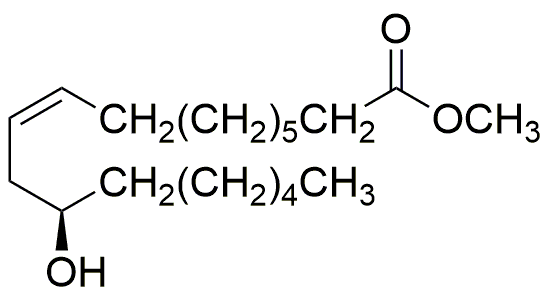Methyl ricinoleate is widely utilized in research focused on
- Cosmetic Formulations: This compound is often used in skin care products due to its moisturizing properties, making it ideal for lotions and creams that aim to hydrate and soothe the skin.
- Lubricants: Methyl ricinoleate serves as a bio-based lubricant in various industrial applications, providing a sustainable alternative to petroleum-based lubricants, which can be harmful to the environment.
- Pharmaceuticals: In the pharmaceutical industry, it acts as a surfactant and emulsifier, enhancing the delivery of active ingredients in topical and oral medications.
- Food Industry: It is also used as a food additive, providing a natural source of fatty acids that can improve the texture and stability of food products.
- Biodegradable Plastics: Methyl ricinoleate is being explored in the development of biodegradable plastics, offering an eco-friendly option that reduces reliance on fossil fuels.
General Information
Properties
Safety and Regulations
Applications
Methyl ricinoleate is widely utilized in research focused on
- Cosmetic Formulations: This compound is often used in skin care products due to its moisturizing properties, making it ideal for lotions and creams that aim to hydrate and soothe the skin.
- Lubricants: Methyl ricinoleate serves as a bio-based lubricant in various industrial applications, providing a sustainable alternative to petroleum-based lubricants, which can be harmful to the environment.
- Pharmaceuticals: In the pharmaceutical industry, it acts as a surfactant and emulsifier, enhancing the delivery of active ingredients in topical and oral medications.
- Food Industry: It is also used as a food additive, providing a natural source of fatty acids that can improve the texture and stability of food products.
- Biodegradable Plastics: Methyl ricinoleate is being explored in the development of biodegradable plastics, offering an eco-friendly option that reduces reliance on fossil fuels.
Documents
Safety Data Sheets (SDS)
The SDS provides comprehensive safety information on handling, storage, and disposal of the product.
Product Specification (PS)
The PS provides a comprehensive breakdown of the product’s properties, including chemical composition, physical state, purity, and storage requirements. It also details acceptable quality ranges and the product's intended applications.
Certificates of Analysis (COA)
Search for Certificates of Analysis (COA) by entering the products Lot Number. Lot and Batch Numbers can be found on a product’s label following the words ‘Lot’ or ‘Batch’.
*Catalog Number
*Lot Number
Certificates Of Origin (COO)
This COO confirms the country where the product was manufactured, and also details the materials and components used in it and whether it is derived from natural, synthetic, or other specific sources. This certificate may be required for customs, trade, and regulatory compliance.
*Catalog Number
*Lot Number
Safety Data Sheets (SDS)
The SDS provides comprehensive safety information on handling, storage, and disposal of the product.
DownloadProduct Specification (PS)
The PS provides a comprehensive breakdown of the product’s properties, including chemical composition, physical state, purity, and storage requirements. It also details acceptable quality ranges and the product's intended applications.
DownloadCertificates of Analysis (COA)
Search for Certificates of Analysis (COA) by entering the products Lot Number. Lot and Batch Numbers can be found on a product’s label following the words ‘Lot’ or ‘Batch’.
*Catalog Number
*Lot Number
Certificates Of Origin (COO)
This COO confirms the country where the product was manufactured, and also details the materials and components used in it and whether it is derived from natural, synthetic, or other specific sources. This certificate may be required for customs, trade, and regulatory compliance.


